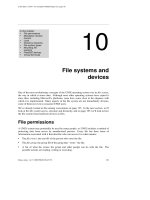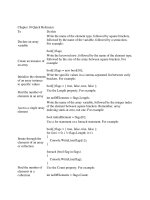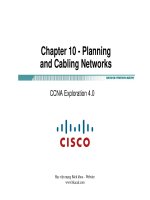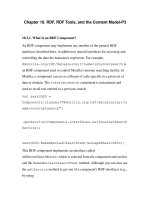Chapter+10+ firewalls
Bạn đang xem bản rút gọn của tài liệu. Xem và tải ngay bản đầy đủ của tài liệu tại đây (825.7 KB, 35 trang )
Cryptography and Network Security
Chapter 10
Firewalls
Lectured by
Nguyễn Đức Thái
Outline
The Need for Firewalls
Firewall Characteristics
Types of Firewalls
Firewall Basing
Firewall Location and Configurations
2
Key Points
A firewall forms a barrier through which the traffic going
in each direction must pass. A firewall security policy
dictates which traffic is authorized to pass in each
direction.
A firewall may be designed to operate as a filter at the
level of IP packets, or may operate at a higher protocol
layer.
Firewalls can be an effective means of protecting a local system or network of
systems from network-based security threats while at the same time affording
access to the outside world via wide area networks and the Internet
3
The Needs for Firewalls
Where we need firewalls?
Centralized data processing system, with a central mainframe
supporting a number of directly connected terminals
Local area networks (LANs) interconnecting PCs and
terminals to each other and the mainframe
Premises network, consisting of a number of LANs,
interconnecting PCs, servers, and perhaps a mainframe or
two
Enterprise-wide network, consisting of multiple,
geographically distributed premises networks interconnected
by a private wide area network (WAN)
Internet connectivity, in which the various premises networks
all hook into the Internet and may or may not also be
connected by a private WAN
4
What is a Firewall?
5
What is a Firewall?
1. A firewall defines a single choke point that keeps
unauthorized users out of the protected network, prohibits
potentially vulnerable services from entering or leaving the
network, and provides protection from various kinds of IP
spoofing and routing attacks. The use of a single choke point
simplifies security management because security capabilities
are consolidated on a single system or set of systems.
2. A firewall provides a location for monitoring security-related
events. Audits and alarms can be implemented on the
firewall system.
6
What is a Firewall?
3. A firewall is a convenient platform for several Internet
functions that are not security related. These include a
network address translator, which maps local addresses to
Internet addresses, and a network management function
that audits or logs Internet usage.
4. A firewall can serve as the platform for IPsec. Using the
tunnel mode capability, the firewall can be used to
implement virtual private networks.
7
Firewall Characteristics
Design goals for a firewall
All traffic from inside to outside, and vice versa, must pass
through the firewall. This is achieved by physically blocking all
access to the local network except via the firewall. Various
configurations are possible.
Only authorized traffic, as defined by the local security policy,
will be allowed to pass. Various types of firewalls are used,
which implement various types of security policies.
The firewall itself is immune to penetration. This implies the
use of a hardened system with a secured operating system.
Trusted computer systems are suitable for hosting a firewall
and often required in government applications.
8
Firewall Characteristics
Firewalls have been evolved, provide services:
Service control: Determines the types of Internet services that can be
accessed, inbound or outbound. The firewall may filter traffic on the basis
of IP address, protocol, or port number; may provide proxy software that
receives and interprets each service request before passing it on; or may
host the server software itself, such as a Web or mail service.
Direction control: Determines the direction in which particular service
requests may be initiated and allowed to flow through the firewall.
User control: Controls access to a service according to which user is
attempting to access it. This feature is typically applied to users inside the
firewall perimeter (local users). It may also be applied to incoming traffic
from external users; the latter requires some form of secure
authentication technology, such as is provided in IPsec (Chapter 19).
Behavior control : Controls how particular services are used. For example,
the firewall may filter e-mail to eliminate spam, or it may enable external
access to only a portion of the information on a local Web server.
9
Firewall Characteristics
Firewalls capability:
A firewall defines a single choke point that keeps unauthorized users out
of the protected network, prohibits potentially vulnerable services from
entering or leaving the network, and provides protection from various
kinds of IP spoofing and routing attacks. The use of a single choke point
simplifies security management because security capabilities are
consolidated on a single system or set of systems.
A firewall provides a location for monitoring security-related events.
Audits and alarms can be implemented on the firewall system.
A firewall is a convenient platform for several Internet functions that are
not security related. These include a network address translator, which
maps local addresses to Internet addresses, and a network management
function that audits or logs Internet usage.
A firewall can serve as the platform for IPsec. Using the tunnel mode
capability, the firewall can be used to implement virtual private networks.
10
Firewall Limitations
1. The firewall cannot protect against attacks that bypass the
firewall. Internal systems may have dial-out capability to
connect to an ISP. An internal LAN may support a modem
pool that provides dial-in capability for traveling employees
and telecommuters.
2. The firewall may not protect fully against internal threats,
such as a disgruntled employee or an employee who
unwittingly cooperates with an external attacker.
3. An improperly secured wireless LAN may be accessed from
outside the organization. An internal firewall that separates
portions of an enterprise network cannot guard against
wireless communications between local systems on
different sides of the internal firewall.
4. A laptop, PDA, or portable storage device may be used and
infected outside the corporate network, and then attached
and used internally.
11
Types of Firewalls
A firewall may act as a packet filter.
It can operate
• as a positive filter, allowing to pass only packets that meet
specific criteria,
or
• as a negative filter, rejecting any packet that meets certain
criteria.
Depending on the type of firewall, it may examine one or
more protocol headers in each packet, the payload of each
packet, or the pattern generated by a sequence of packets.
12
Packet Filtering Firewall
A packet filtering firewall applies a set of rules to each
incoming and outgoing IP packet and then forwards or
discards the packet.
The firewall is typically configured to filter packets going in
both directions (from and to the internal network)
13
Packet Filtering Firewall
Filtering rules are based on information contained
in a network packet:
•
•
•
•
•
Source IP address
Destination IP address
Source and destination transport-level address: port
IP protocol field: (Defines the transport protocol)
Interface: (For a firewall with three or more ports, which interface of the
firewall the packet came from or which interface of the firewall the packet is
destined for)
14
Packet Filtering Firewall
The packet filter is typically set up as a list of rules
based on matches to fields in the IP or TCP header.
If there is a match to one of the rules, that rule is
invoked to determine whether to forward or discard
the packet.
If there is no match to any rule, then a default action
is taken.
Two default policies are possible:
• Default = discard: That which is not expressly permitted is prohibited.
• Default = forward: That which is not expressly prohibited is permitted.
15
Packet Filtering Firewall
16
Firewalls – Packet Filters
17
Attacks on Packet Filters
IP Address Spoofing
• fake source address to be trusted
• add filters on router to block
Source Routing Attacks
• attacker sets a route other than default
• block source routed packets
Tiny Fragment Attacks
• split header info over several tiny packets
• either discard or reassemble before check
18
IP Address Spoofing
The intruder transmits packets from the outside with
a source IP address field containing an address of an
internal host.
The attacker hopes that the use of a spoofed
address will allow penetration of systems that
employ simple source address security, in which
packets from specific trusted internal hosts are
accepted.
The countermeasure is to discard packets with an
inside source address if the packet arrives on an
external interface.
In fact, this countermeasure is often implemented at
the router external to the firewall
19
Tiny Fragment Attacks
The intruder uses the IP fragmentation option to create
extremely small fragments and force the TCP header
information into a separate packet fragment.
Typically, a packet filter will make a filtering decision on the
first fragment of a packet.
All subsequent fragments of that packet are filtered out
solely on the basis that they are part of the packet whose
first fragment was rejected.
The attacker hopes that the filtering firewall examines only
the first fragment and that the remaining fragments are
passed through.
A tiny fragment attack can be defeated by enforcing a rule
that the first fragment of a packet must contain a predefined
minimum amount of the transport header.
If the first fragment is rejected, the filter can remember the
packet and discard all subsequent fragments.
20









